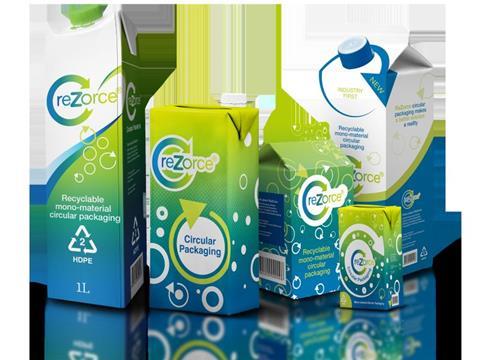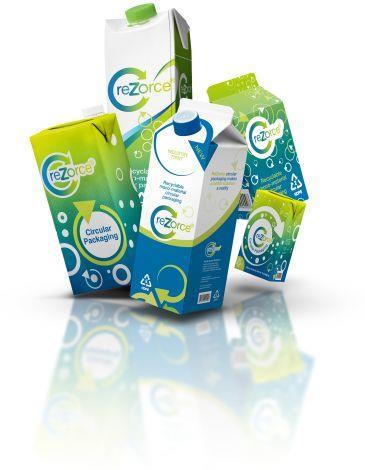
ReZorce, devised by UK-based company Zotefoams is a mono-material HDPE recyclable barrier food and beverage packaging that sets out to be an alternative for multilayer beverage cartons. Elisabeth Skoda talks to Zotefoams’ Group CEO David Stirling and Neil Court-Johnston, VP Strategy EMEA for ReZorce® to find out more.
Can you tell us a bit more of the development process for ReZorce?
David Stirling: The principle of ReZorce is very simple. It is made from high density polyethylene (HDPE), with a few additives that don't affect recycling. HDPE is used in many packaging applications, such as milk bottles, and is widely recycled across the world. The key difference is the structure. Instead of making a monolayer, we make multiple layers, solid foam on solid foam, which makes it very difficult for the oxygen and moisture molecules to travel through the product, and thus increasing the barrier properties. But it still is HDPE, and therefore it can be put in standard home recycling stream. The other benefit of having numerous layers is that it facilitates the use of recycled materials. As there is a shortage in high quality recycled material, we can put the recyclate in the inside layers, where it doesn’t touch the food.
Neil Court-Johnston: Everything that you can do today with cartonboard, we believe can be done with ReZorce. The material is also suitable for use in other applications, such as pouches or tubes, but we are starting with drinks cartons because that's the most concentrated market, and the market where the recycling industry has the biggest pool.
Were there any challenges when it came to developing the material?
David Stirling: One of the biggest challenges, once we understood how to make the barrier structure, was the surface. When you foam any plastics, you usually get a slightly rough surface. It feels like orange peel and is difficult to print on. We spent quite a long time perfecting the surface to get the optimal print quality. Having the capability for surface printing is important as it enables on-pack labelling or mass customisation. This is a technology still in development, but we have a South American partner who is very close to commercialisation. We should be getting into production within a few months.
The product design features microbubbles within the layers. What role do they play to boost functionality?
David Stirling: The microbubbles improve vapour transmission and barrier properties. Furthermore, have you ever tried to fold a plastic sheet? It's very difficult. It doesn't fold cleanly and evenly, and the surface is difficult to print on. Our technology is foldable, as the bubbles allow compression. You can go from flat sheet to a corner very easily. This means that it can be treated and processed just like cartonboard, which in turn means there's no scale up problem. It can be extruded as normal and it can go on a standard filling machine in the same way because it can be folded and joint sealed very easily.
Are there any differences in product protection and shelf life to standard beverage cartons?

Neil Court-Johnston: We design the structures to give the right barrier properties and stiffness for different products. That will be different from a 100ml apple juice to a 1000 ml milk carton. We don't know yet if there will be any difference in consumer experience when we go to mass market and we have millions of these cartons out. Drop tests, for example, will have to be done customer by customer, but I don't anticipate any problems.
Do you anticipate any challenges around filling machines?
Neil Court-Johnston: Some machines need aluminium to create a heat seal, and Zotefoams doesn't have that, but there's a modification available to address this. Otherwise, it will work on standard machines.
Can ReZorce cartons be recycled with plastics in various different countries?
David Stirling: As far as we know, they can be recycled in every country. Whether the country does recycle or not, that's a different question, but it is compatible with all ETP recycling processes and sorting.
Neil Court-Johnson: We've run recycling trials in Ireland, in the UK, in Germany, and also in North and South America. We're working with recyclers and anticipate certification in the next few weeks. Another aspect to highlight here is scalability. I was involved with Nampak, and the UK dairy roadmap, where we created a closed loop circular recycling system for milk bottles. That's what we're aiming to achieve with ReZorce containers, because they're monomaterial. The only difference between a milk bottle and a ReZorce container is that the HDPE milk bottle is monolayer and ReZorce containers can contain between three and nine layers. Reuse is difficult with monolayer HDPE, as it becomes discoloured, brittle, and quality and performance of the polymer diminishes over the number of cycles. Seams can leak when put under pressure, resulting in customer complaints. We address that issue with our technology.
Would a ReZorce carton from 100% recycled HDPE be possible?
David Stirling: In the future, certainly. Today, most countries do not allow recycled content to be mixed with food or beverages. But if you go into chemical recycling, it comes back essentially as virgin material. In our trials, the highest recycled content rate we achieved was around 70%. We are starting with less than that because of availability of high volumes of good quality recycled materials, but the technology is future proof. As the recycling industry catches up, we can put more and more in. The volumes we're talking about are large, we already have interest for over 500 million cartons. It becomes more difficult to source high quality at high volumes. We want to start at a reasonable level and then grow as the industry grows.
In conclusion, how do Life Cycle Assessments compare to standard cartons/bottles?
Neil Court-Johnson: We worked with Dr. Alan Campbell, who developed one of the most commonly used LCA models. We benchmarked a 1 litre ReZorce beverage carton against the current market standard. It was demonstrated that the process uses eleven times less water, five times less energy, half the carbon emissions, and interestingly, Dr. Campbell also concluded that even where mixed material beverage cartons are recycled, the LCA from ReZorce offers a more attractive solution environmentally.











